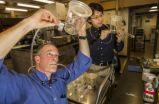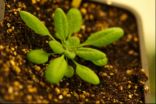(Press-News.org) PROVIDENCE, R.I. [Brown University] — If studying a single gene or a diet that might extend longevity is like searching for a fountain of youth, then a new study calls for looking at something more like the whole watershed. Brown University biologists who experimentally throttled three such factors in fruit flies found that lifespan depended more on interactions among the factors than on the factors themselves.
"I think the main lesson is that these interaction effects are as significant or important as the [single] effects, such as diet effects alone or genetic effect alone," said David Rand, professor of biology and senior author of the study published in the journal PLoS Genetics. "Traditionally that's what people have focused on: looking for a gene that extends longevity or a diet that extends longevity."
When researchers have looked at single or even pairs of factors in a wide variety of organisms, they've made many valuable findings about the biology of aging, Rand said. But sometimes scientists have been unable to replicate each other's findings in seemingly similar experiments. Often this is attributed to mysterious "background effects," presumably other genes that were not properly accounted for. The new study chose to put such background effects into the foreground to examine dietary effects on aging in several panels of different nuclear and mitochondrial genetic pairings.
The study's results suggest that many observed effects of calorie or diet restriction or different genes on lifespan may depend on a more intricate context than has been understood so far.
Rather than despairing that combinatorial interactions of diets, nuclear genes, and mitochondrial genes make the underlying biology of aging intractably complex, Rand and lead author Chen-Tseh Zhu said studies that explicitly embrace such multifactorial interactions can lead researchers to understand the inherent biological complexity of the aging process: Many genes, many cells, and many environments all contribute to the aging process. With such observations they could then trace which mitochondrial genes moderate which nuclear genes in response to a particular diet.
"Focused studies of single factors that prove unrepeatable in different backgrounds are not general results," Rand said. "But the interaction between these factors may get us closer to generalities."
Zhu makes an analogy to personalized medicine, in which doctors and scientists hope that by digging deeper into a person's genomic details, they'll be able to predict whether specific drugs can be targeted to individuals with particular combinations of genes, thus avoiding dangerous side effects or producing better treatment.
"Personalized genomic medicine is not to disprove what has been done in medicine so far, but to bring it to another level so that in the future when you are going to design the best medication for a given person you want to investigate their genes and their metabolism," said Zhu, a postdoctoral scholar. "A combination of factors brings you more information."
Complicated combinations
For the study Rand, Zhu and undergraduate co-author Paul Ingelmo generated 18 lines of flies by mixing and matching different mitochondrial and nuclear genomes in individuals from two different species. Then they fed members of each of those fly populations from a menu of five different diets. Some diets held calories constant but varied the balance between yeast (protein) and sugar (carbs), while some diets varied the total calories but kept the proportions of nutrients constant.
In several cases described in the paper, the team saw how interactions among the three factors they manipulated could produce results that would thoroughly frustrate people who were too focused on just one factor.
For example, in flies with the "w1118" nuclear genome and the "OreR" mitochondrial genome, lifespan was greatest with the high-sugar, low-yeast diet and significantly worse with the diet that balanced yeast and sugar evenly. But for flies with the same nuclear genome but the "Zim" mitochondrial genome, the balanced diet was just as good, if not slightly better than the high-sugar, low-yeast meals.
So is it time to recommend that w1118 flies buzz over to the candy store for diet five? That, it turns out, depends on their mitochondrial genome, according to the research.
Another illustrative finding was that the sirt1 nuclear gene, which is an important but controversial gene in aging research, Rand said, shows different effects on longevity given different mitochondrial genomes.
Future work can focus on tracing the physiological and biochemical pathways suggested by these multidimensional interactions, Rand said.
"What this does is identify genetic interactions that themselves are modified by diet," Rand said. "It just means we have to drill down on these things and understand how the various genes that affect aging interact with one another. If you get the right combination of genes, you might be able to map a two-gene response to different diets right down to individual molecules 'talking to each other' in different ways."
INFORMATION:
The National Institute on Aging (grant: R01AG027849) and the National Institutes of General Medicine (grant: R01GM067862) supported the work.
Complex interactions may matter most for longevity
2014-05-16
ELSE PRESS RELEASES FROM THIS DATE:
How some trypanosomes cause sleeping sickness while others don't
2014-05-16
Trypanosome parasites transmitted by tsetse flies cause devastating diseases in humans and livestock. Different subspecies infect different hosts: Trypanosoma brucei brucei infects cattle but is non-infectious to humans, whereas T. b. gambiense and T. b. rhodesiense cause sleeping sickness in humans. A study published on May 15th in PLOS Pathogens reveals how humans can fight off some trypanosomes but not others.
Sam Alsford, from the London School of Hygiene and Tropical Medicine, UK, and colleagues, undertook a comprehensive search for genes that make T. b. brucei ...
Walking may have profound benefits for patients with kidney disease
2014-05-16
Washington, DC (May 15, 2014) — For individuals with kidney disease, walking may help prolong life and reduce the risk of needing dialysis or a kidney transplant. That's the conclusion of a study appearing in an upcoming issue of the Clinical Journal of the American Society of Nephrology (CJASN).
Physical inactivity is common among patients with chronic kidney disease (CKD). Che-Yi Chou MD, PhD, Chiz-Tzung Chang, PhD (China Medical University Hospital, in Taiwan) and their colleagues looked to see if an activity as simple as walking might provide benefits to patients. ...
New tool to grow cancer cells streamlines laboratory research
2014-05-16
VIDEO:
Georgetown Lombardi Comprehensive Cancer Center researcher Anna T. Riegel, PhD, discusses a new technique that allows the growth of both normal and cancer cells and keeps them alive indefinitely is...
Click here for more information.
WASHINGTON — A new technique that allows the growth of both normal and cancer cells and keeps them alive indefinitely is transforming and expediting basic cancer research, say investigators from Georgetown Lombardi Comprehensive Cancer Center. ...
New kidney allocation policy could improve the success of transplantations in the US
2014-05-16
Washington, DC (May 15, 2014) — A newly approved US policy regarding allocation of kidneys from deceased donors will likely improve patient and transplant survival, according to a study appearing in an upcoming issue of the Journal of the American Society of Nephrology (JASN). The true effects of the new policy are yet to be seen, however, and officials will evaluate its intended and unintended consequences on an ongoing basis.
In 2013, the Organ Procurement and Transplantation Network in the United States approved a new national deceased donor kidney allocation policy ...
Novel genetic mechanism protects plants from toxic zinc
2014-05-16
Zinc is essential for optimal plant growth and development but when high levels of the metal are present in the soil, it can become toxic to the plant. Consequently, plants need to trigger mechanisms capable of coping with that stress. Researchers from the Instituto Gulbenkian de Ciência (IGC) have now discovered a novel genetic mechanism that protects plants from toxic zinc levels. The research team, led by Paula Duque, identified a gene that produces a protein capable of sequestering zinc inside the cells of the root. In the presence of high levels of zinc, this gene ...
Tumor cells in the blood may indicate poor prognosis in early breast cancer
2014-05-15
Tumor cells in bone marrow of early breast cancer patients predict a higher risk of relapse as well as poorer survival, but bone marrow biopsy is an invasive and painful procedure. Now, it may be possible to identify tumor cells in a routine blood sample and use them as prognostic markers, according to a study published May 15 in the Journal of the National Cancer Institute.
To assess the prognostic value of circulating tumor cells (CTCs) in patients with early breast cancer, Brigitte Rack, M.D., of the Department of Gynecology and Obstetrics, Klinikum Innenstadt, ...
Older migraine sufferers may have more silent brain injury
2014-05-15
DALLAS, May 15, 2014 — Older migraine sufferers may be more likely to have silent brain injury, according to research published in the American Heart Association’s journal Stroke.
In a new study, people with a history of migraine headaches had double the odds of ischemic silent brain infarction compared to people who said they didn’t have migraines. Silent brain infarction is a brain injury likely caused by a blood clot interrupting blood flow to brain tissue. Sometimes called “silent strokes,” these injuries are symptomless and are a risk factor for future strokes.
Previous ...
Study -- overweight teens more likely to be rejected as friends by normal weight peers
2014-05-15
Tempe, Ariz. (May, 15, 2014) - Overweight young people are more likely to be rejected as friends by peers who are of normal weight, according to new research by Arizona State University social scientists.
"Using Social Network Analysis to Clarify the Role of Obesity in Adolescent Friend Selection," published in the American Journal of Public Health by Arizona State University Associate Professors David R. Schaefer of the School of Human Evolution and Social Change and Sandra D. Simpkins of the T. Denny Sanford School of Social and Family Dynamics, used social network ...
2 JAMA Ophthalmology studies focus on glaucoma medication adherence
2014-05-15
Electronic monitoring to measure medication adherence by patients with glaucoma documented that a sizable number of patients did not regularly use the eye drops prescribed to them.
Topical medications for glaucoma lower intraocular pressure and can delay or slow the progression of the eye disease. Medication adherence is important.
Patients who were treated with once-daily prostaglandin eye drops were recruited from a university-based glaucoma clinic. Patients were given a container with an electronic cap in which to store their eye drops. The cap recorded each ...
NYC safe routes to school program reduces injuries and saves hundreds of millions of dollars
2014-05-15
As Bike to Work week continues, New Yorkers got some good news from a team of researchers at Columbia University's Mailman School of Public Health. Using funds from the federally funded Safe Routes to School program enacted in 2005 in an effort to create safe environments for American children to walk or bike to school, New York City made safety changes to the most dangerous intersections near schools. These interventions included narrowing intersections by building out sidewalks, setting off dedicated bicycle lanes, and installing speed humps, and timing lights so pedestrians ...


